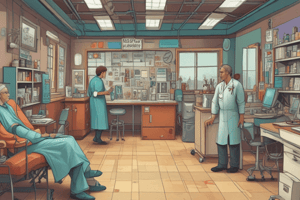Podcast
Questions and Answers
What is the primary focus of the lecture on Environmental Sanitation & Safe Water Supply?
What is the primary focus of the lecture on Environmental Sanitation & Safe Water Supply?
- Treatment of common diseases & injuries
- Control of local endemic diseases
- Proper nutrition
- Environmental sanitation & safe water supply (correct)
What does the term 'environment' include according to the lecture?
What does the term 'environment' include according to the lecture?
- Physical elements only
- Biologic elements only
- Social elements only
- Physical, biologic, and social elements (correct)
Which of the following is considered a waste that can cause health problems according to the lecture?
Which of the following is considered a waste that can cause health problems according to the lecture?
- Industrial and agricultural wastes (correct)
- Insects and bacteria
- Customs and cultures
- Plants and animals
What is the primary purpose of sanitation as mentioned in the lecture?
What is the primary purpose of sanitation as mentioned in the lecture?
Which of the following is a characteristic of hazardous waste?
Which of the following is a characteristic of hazardous waste?
Which type of sanitation is responsible for environmental and food sanitation programs?
Which type of sanitation is responsible for environmental and food sanitation programs?
What can unsafe housing cause due to poor air quality, temperature, hazardous substances, and sanitation?
What can unsafe housing cause due to poor air quality, temperature, hazardous substances, and sanitation?
Which method can be used to purify water?
Which method can be used to purify water?
What should disinfectants used in water supplies do?
What should disinfectants used in water supplies do?
What types of infection can result from biological harms of water?
What types of infection can result from biological harms of water?
What are the parameters in drinking water related to chemical substances?
What are the parameters in drinking water related to chemical substances?
What is the indicator of potential fecal contamination in water?
What is the indicator of potential fecal contamination in water?
What is the main impact of housing and indoor environment on health?
What is the main impact of housing and indoor environment on health?
What may substandard housing lack?
What may substandard housing lack?
What is essential for health and socio-economic development?
What is essential for health and socio-economic development?
What can lead to health risks related to water contamination?
What can lead to health risks related to water contamination?
Flashcards are hidden until you start studying
Study Notes
- Recyclable material is solid waste that is processed and returned to the economic mainstream.
- Hazardous waste is dangerous or potentially harmful to human health and the environment.
- Types of sanitation include: basic, on-site, food, environmental, and ecological sanitation.
- Environmental health administration is responsible for directing environmental and food sanitation programs.
- Housing and indoor environment significantly impact physical, mental, and social health.
- Unsafe housing can cause injuries and health threats due to poor air quality, temperature, hazardous substances, and sanitation.
- Substandard housing may lack adequate sanitation, clean water, heating or cooling, and be structurally unsound.
- Access to safe water is essential for health and socio-economic development.
- Water can be contaminated naturally or through human activities, leading to health risks.
- Biological harms of water include infections from viruses, bacteria, protozoa, and helminthes.
- Chemical harms include contamination from detergents, solvents, cyanides, heavy metals, nitrogenous substances, and bleaching agents.
- Water can be purified through boiling, storage, chemical disinfection, filtration, ozone gas, ultraviolet radiation, or reverse osmosis.
- Disinfectants used in water supplies should effectively destroy pathogens without leaving toxic byproducts.
- Parameters in drinking water include physical parameters (color, taste, odor, turbidity, pH, TDS) and chemical substances (barium, fluoride, lead, mercury, nitrate, nitrite, selenium).
- Coliform bacteria are used as an indicator of potential fecal contamination in water.
Studying That Suits You
Use AI to generate personalized quizzes and flashcards to suit your learning preferences.




